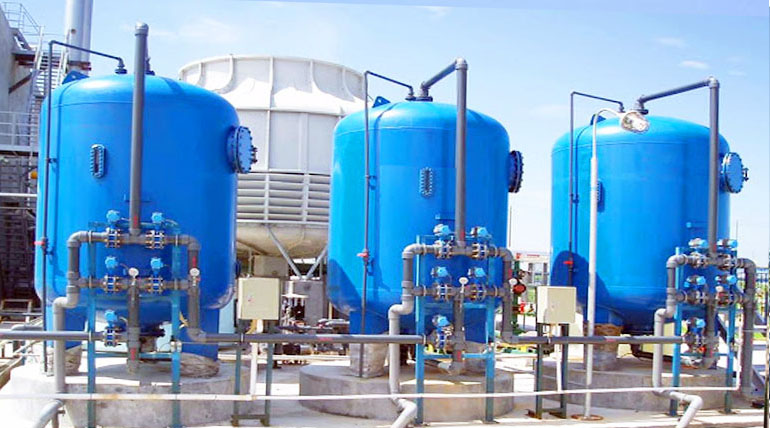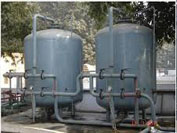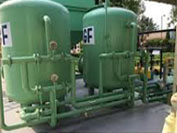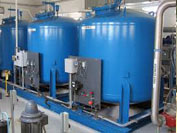PRODUCTS & SERVICES




Filtration Plants
Water filter removes impurities from water by means of a fine physical barrier from a chemical process or a biological process. Filters can be used for suspended solids removal, removal of organics, odour, oil& grease, iron etc by selecting the right type of medium for filtration. We offer a wide range of water filtration systems that provide you clean & healthy water to use. Entire range of filter are available in different moc like FRP, MS, MSRL, SS etc. They are available in fully automatic, remotely operated, manually operated or with multiport valves.
A) Multi Grade Filters (MGF)
KREYWIN provides multi grade filters – MGF, of varied capacities. An MGF is used in water and wastewater treatment to remove suspended solids, dust and dirt present in the water. The MGF is a depth filter that makes use of coarse and fine media to create pore dimensions that retain large and small suspended particles. These filters work at high velocities and have high dirt holding capacity. These MGFs are used for pre-treatment in ion exchangers (deionizer and softener) and membrane filtration systems.
B) Dual Media Filter (DMF)
KREYWIN provide dual media filters - DMF for the removal of suspended solids and turbidity in water and wastewater. DMF filters work on the principal of depth filtration. The principal media in these filters is quartz grade sand and anthracite. Other supporting media include pebbles of various sizes, crushed gravel and silex. DMFs are ideal to filter water with very fine suspended matter like mud, dust particles and biological growth at a high rate of flow.
The major advantage of this kind of filters is that anthracite which provides for coarse filtration is lighter than filtering sand. Due to which one stage of coarse filtration takes place on the anthracite bed and the next stage takes place on the sand bed. Thus, depth filtration is achieved. Since both media (viz sand and anthracite) are employed, the dirt loading capacity of these filters is twice that of pressure sand filters. Hence these types of filters are more capable and give high performance. To conclude DMF performs better than the single filtration process.
C) Pressure Sand Filter (PSF)
We provide pressure sand filter – PSF. These filters have multiple layers of sand of varied size and specific gravity. The PSF is designed to remove turbidity and suspended particles present in the feed water with minimum pressure drop. PSFs operate at lower velocities compared to MGFs.
D) Activated Carbon Filter (ACF)
KREYWIN offers a wide range of Activated Carbon Filters - ACF, for varied applications to meet specific process requirements. The activated carbon filter (ACF) works on the principle of adsorption. The principal media in these filters is activated carbon. Other supporting media include pebbles of various sizes, crushed gravel and silex. The activated carbon is a highly porous media. This property of carbon allows it to adsorb the free chlorine in raw water. Also, organic matter present in colloidal form, color, oil & grease is adsorbed in these pores. Thus, odour emanating from raw water on account of these colloids is reduced. Various grades of carbon are used according to the type of treatment required. The activated carbon present in the standard range has an iodine value of 450. This carbon is also available in iodine values of 600, 900 and 1200.Our ACFs are used as second stage filtration post MGF/PSF in effluent, sewage, water treatment plants, ETP, STP, WTP.
E) Gravity Filters / AVGF
For larger flow rates where pumping is a constraint, we suggest gravity filter, also known as rapid sand filters, usually at the outlet of pretreatment plant. This reduces pumping requirement and can be a good choice where space availability is not a constraint. AVGF is a boon for places which are remotely located where operators cannot attend on regular basis. Automatic valve-less gravity filter comes with a unique feature of initiating backwash based on pressure drop and it does not involve any automation products such as auto-valves, controllers, PLC etc. It operates on gravity and backwashes purely on delta-p using simple hydraulic principles. AVGF are ideally suited for village water supply schemes and remote locations.
F) Iron Removal Filter (IRF)
Iron is the primary source for discoloration problems in the drinking water distribution system. Water percolating through soil and rocks dissolves iron present in it, which subsequently enters into ground water bodies. In deep wells and springs, where both oxygen and pH content tend to be low, water containing dissolved iron appears colorless. When the same water is exposed to air, the dissolved iron reacts with atmospheric oxygen and converts to yellow-colored suspended particles which finally forms a reddish-brown residue. High concentration of iron cause reddish brown stains on laundry and household fixtures, sometimes clogs water distribution pipes and imparts a bittersweet or metallic taste to drinking water.
U.S. Environmental Protection Agency (USEPA) have listed iron and manganese in secondary drinking water standards, applicable to drinking water contaminants that cause offensive taste, odour, color, corrosion, foaming or staining problems. Secondary drinking water contaminants do not pose risks to humans at the levels usually found in natural water. As per USEPA (June 2003) and WHO Guideline 2006, drinking water standard for iron is 0.3 ppm.
The removal of iron from groundwater is a common treatment step in the production of drinking water. Even when clear water meets the drinking water standards, the water quality in the distribution system can deteriorate due to settling of iron (hydroxide) particles or post-treatment flocculation of dissolved iron. Therefore, it is important to remove dissolved and particulate iron to a large extent. The principal media in these filters is manganese dioxide. Other supporting media include pebbles of various sizes, crushed gravel and silex if Mno2 is used. Manganese dioxide catalyzes precipitation of iron and holds back the precipitated matter on the filter bed. These are used to remove iron from ground waters.
Another method based on ion exchange resin technology is to use ISR Resin. INDION®ISR*(Iron Specific Resin) is based on ion exchange resin technology and has manganese dioxide as a catalytic moiety. It works as a catalyst to promote iron oxidation. Basically, iron and oxygen are attracted to manganese dioxide, which enhances the oxidation of dissolved iron and converts the soluble iron (Fe++) into insoluble ferric (Fe+++), which can be filtered through the media that acts as catalyst in this process and does not get consumed. In this reaction, manganese dioxide is reduced to manganese oxide and ferric hydroxide is precipitated. During backwash, the surface of this material is scoured, converting ittoMnO2, which is further used to oxidize the iron. Simple backwash regenerates manganese dioxide. No chemicals are required to regenerate the resin.




